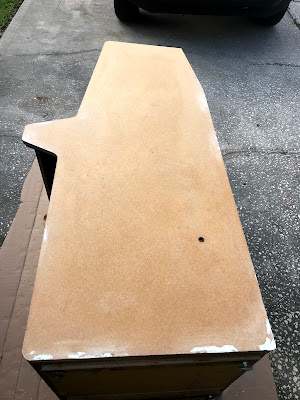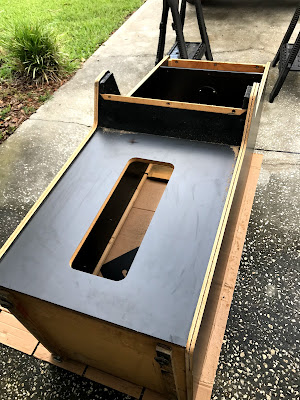In an earlier post I mentioned this cabinet wasn't in the best shape. Normally, if the damage isn't real bad, or the side art is just pealing up around the edges, I'll just have a go at cleaning up the cabinet and getting things looking acceptable. For this game, since it has a unique look, and a really awesome design, I've decided to do a full restore of the side art, and laminate sections.
Having a quick look on KLOV, there were a couple of excellent documented restorations of this same cabinet. Seeing how good they worked out, I took the same route. I ordered up 3 sheets of WilsonArt vertical grade satin/matte laminate in black. If you're careful you can get by with just two sheets, luckily I had three, because I had a few accidents.
To remove the artwork and vinyl coating I used a product called Quick-Strip. It gets globbed on, since it's a gel, and really just eats away at whatever it touches. So in about 20 minutes, the black covering started to bubble up and wrinkle. Then I just used a scrapper and worked it up as best I could. I should mention that I used painters tape around the edges to keep the Quick-Strip from dripping down over the sides. Also, I wore a respirator, but I ran out of plastic gloves. I would recommend using gloves, since afterwards, and for about 3 days, I didn't have much feeling in the ends of my fingers. And this was with touching it very little, just enough to pull up small sections of the rubbery vinyl.
You can also see that some of the edges had the usual water damage, and bangs and bruises. For those I mixed up several batches of Bondo, followed by careful sanding. The lower back corners were almost completely gone, and those needed built up and shaped to look original. This whole process took several days.
If you've never applied laminate, you're in for a treat. While it absolutely blows away any finish you can usually achieve with paint, it's a pain in the butt to get right.
First thing is it comes in a 4x8 sheet, which is somewhat fragile, you can't bang it on anything, or bend it too much, or it will crack or snap. You then need to cut a piece from the sheet, which is approximately the size of your surface, again being careful not to break or crack the laminate.
Perhaps there are better ways, but I used a contact cement. This stuff gets painted on both the cabinet and the back of the laminate, then left to dry for about 25 minutes. Once that's dry, you have to "carefully" bring the two surfaces together. The moment they touch, it's game over, that stuff wont come loose, and there is no adjustment possible. So I used a few wood dowels between the two surfaces, then pulled them out one at a time once the alignment was correct. Oh, and almost forgot, if you have even a spec of dirt, a bit of saw dust, anything between the two surfaces, it will show as a bump when finished. Ask me how I know.
Once the laminate is applied, I used a roller, designed for pressing down laminate, and rolled the whole thing over and over with a good deal of pressure, again being careful not to crack the edges.
Lastly the whole outer edge was cut using a tracing router bit. That's the easy part. Notice I don't have any pictures of the previously mentioned steps, that's likely due to the frustration I was going through.
One trick I learned, don't apply the contact cement with a paint brush, use a flat spatula type spreader, and just pour a small amount on the surface and quickly spread it around. It's much easier, and you can get a much thinner layer down, much faster too. Just don't let the lady of the house see you sneaking out with the spatula.
Once the laminate is all on and neatly trimmed, it's a thing of beauty and a joy forever. Sorry about those pictures, I was dodging rain showers most of the time just to get this done.
I also patched up those damaged areas on the inner panels above the control panel area. One of them actually still had a large piece of screw still embedded in the surface. To repair this damage took several days of sanding, and filling with Bondo putty, and more sanding. Followed up with layers of high-fill primer, and more sanding until it was smooth, then several layers of satin black enamel paint. Here are a few before and after pictures:
Now that the cabinet issues are sorted, it will receive a good cleaning inside and out, in preparation for the new reproduction artwork, which should be on it's way soon.




















No comments:
Post a Comment